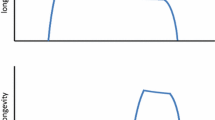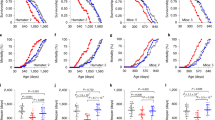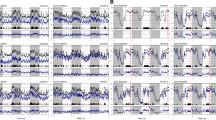Abstract
Golden spiny mice (Acomys russatus) living in the Judean desert are exposed to extended periods of food and water shortage. We investigated their thermal and metabolic response to three weeks of 50 % food reduction at ambient temperatures of 23, 27, 32 and 35 °C by long term records of metabolic rate and body temperature in the laboratory. At all ambient temperatures, A. russatus responded to starvation by a reduction of daily energy expenditure. At 32 and 35 °C, this metabolic adjustment fully compensated the reduced food availability and they maintained their energy balance at a slightly reduced body mass. At lower ambient temperatures, they could not fully compensate for the reduced food availability and kept a negative energy balance. The reduction of daily energy expenditure was largely achieved by the occurrence of daily torpor. Torpor even occurred at high ambient temperatures of 32 and 35 °C during which metabolic depression was not associated with a marked decrease of body temperature. The results show that the occurrence of daily torpor is not necessarily linked to cold exposure and the development of a pronounced hypothermia, but may even occur as depression of metabolic rate in a hot environment.









Similar content being viewed by others
Abbreviations
- T a :
-
Ambient temperature
- T b :
-
Body temperature
- BMR:
-
Basal metabolic rate
- DEE:
-
Daily energy expenditure
- DEI:
-
Daily energy intake
- Tbmin :
-
Minimal body temperature
- MR:
-
Metabolic rate, measured as oxygen consumption
- MRmin :
-
Minimal metabolic rate (during resting phase)
- RMR:
-
Resting metabolic rate (during active phase)
- VO2 :
-
Volume of consumed oxygen
References
Andrews MT (2007) Advances in molecular biology of hibernation in mammals. BioEssays 29:431–440
Berriel Diaz M, Lange M, Heldmaier G, Klingenspor M (2004) Depression of transcription and translation during daily torpor in the Djungarian hamster (Phodopus sungorus). J Comp Physiol B 174:495–502
Buttgereit F, Brand MD (1995) A hierarchy of ATP-consuming processes in mammalian cells. Biochem J 312(Pt 1):163–167
Daan S, Spoelstra K, Albrecht U, Schmutz I, Daan M, Daan B, Rienks F, Poletaeva I, Dell’Omo G, Vyssotski A, Lipp H (2011) Lab mice in the field: unorthodox daily activity and effects of a dysfunctional circadian clock allele. J Biol Rhythms 26:118–129
Dausmann KH, Glos J, Heldmaier G (2009) Energetics of tropical hibernation. J Comp Physiol B 179:345–357
Ehrhardt N, Heldmaier G, Exner C (2005) Adaptive mechanisms during food restriction in Acomys russatus: the use of torpor for desert survival. J Comp Physiol B 175:193–200
Elgar MA, Harvey PH (1987) Basal metabolic rates in mammals: allometry, phylogeny and ecology. Funct Ecol 1:25–36
Elvert R, Heldmaier G (2005) Cardiorespiratory and metabolic reactions during entrance into torpor in dormice, Glis glis. J Exp Biol 208:1373–1383
Elvert R, Kronfeld N, Dayan T, Haim A, Zisapel N, Heldmaier G (1999) Telemetric field studies of body temperature and activity rhythms of Acomys russatus and A. cahirinus in the Judean Desert of Israel. Oecologia 119:484–492
Ferraris RP, Cao QX, Prabhakaram S (2001) Chronic but not acute energy restriction increases intestinal nutrient transport in mice. J Nutr 131(3):779–786
Fluxman S, Haim A (1993) Daily rhythms of body temperature in Acomys russatus: the response to chemical signals released by Acomys cahirinus. Chronobiol Int 10:159–164
Friedman D, Haim A, Zisapel N (1997) Temporal segregation in coexisting spiny mice (Genus Acomys): role of photoperiod and heterospecific odour. Physiol Behav 62:407–411
Gattermann R, Johnston RE, Yigit N, Fritzsche P, Larimer S, Ozkurt S, Neumann K, Song Z, Colak E, Johnston J, McPhee ME (2008) Golden hamsters are nocturnal in captivity but diurnal in nature. Biol Lett 4:253–255
Gutman R, Dayan T (2005) Temporal partitioning: an experiment with two species of spiny mice. Ecology 86:164–173
Gutman R, Choshniak I, Kronfeld-Schor N (2006) Defending body mass during food restriction in Acomys russatus: a desert rodent that does not store food. Am J Physiol Regul Integr Comp Physiol 290:881–891
Gutman R, Yosha D, Choshniak I, Kronfeld-Schor N (2007) Two strategies for coping with food shortage in desert golden spiny mice. Physiol Behav 90:95–102
Haim A, Borut A (1976) Thermoregulation and non-shivering thermogenesis as factors limiting distribution of the golden spiny mouse (Acomys russatus). Isr J Med Sci 12:896
Haim A, Borut A (1981) Heat production and dissipation in golden spiny mice, Acomys russatus from two extreme habitats. J Comp Physiol 142B:445–450
Haim A, Izhaki I (1993) The ecological significance of resting metabolic rate and non-shivering thermogenesis for rodents. J Therm Biol 18:71–81
Haim A, Rozenfeld FM (1993) Temporal segregation in coexisting Acomys species: the role of odour. Physiol Behav 54:1159–1161
Heldmaier G, Elvert R (2004) How to enter torpor: thermodynamic and physiological mechanisms of metabolic depression. In: Barnes BM, Carey HV (eds) Life in the cold: evolution, mechanisms, adaptation, and application, 27 Biological Papers of the University of Alaska, p 185–198
Heldmaier G, Ruf T (1992) Body temperature and metabolic rate during natural hypothermia in endotherms. J Comp Physiol B 162:696–706
Heldmaier G, Klaus S, Wiesinger H, Friedrichs U, Wenzel M (1989) Cold acclimation and thermogenesis. In: Malan A, Canguilhem B (eds) Living in the cold II. John Libbey Eurotext, Paris, pp 347–358
Hut RA, Pilorz V, Boerema AS, Strijkstra AM, Daan S (2011) Working for food shifts nocturnal mouse activity into the day. PLoS ONE 6:e17527
Kleiber M (1932) Body Size and Metabolism. Hilgardia 6:315–353
Körtner G, Geiser F (2009) The key to winter survival: daily torpor in a small arid-zone marsupial. Naturwissenschaften 96:525–530
Kronfeld-Schor N, Dayan T (1999) The dietary basis for temporal partitioning: food habits of coexisting Acomys species. Oecologia 121:123–128
Kronfeld-Schor N, Shargal E, Haim A, Dayan T, Zisapel N, Heldmaier G (2001a) Temporal partitioning among diurnally and nocturnally active desert spiny mice: energy and water turnover costs. J Therm Biol 26:139–142
Kronfeld-Schor N, Dayan T, Elvert R, Haim A, Zisapel N, Heldmaier G (2001b) On the use of the time axis for ecological separation: diel rhythms as an evolutionary constraint. Amer Nat 158:451–457
Levy O, Dayan T, Kronfeld-Schor N (2011a) Adaptive thermoregulation in golden spiny mice: the influence of season and food availability on body temperature. Physiol Biochem Zool 84:175–184
Levy O, Dayan T, Kronfeld-Schor N (2011b) Interspecific competition and torpor in golden spiny mice: two sides of the energy-acquisition coin. Integr Comp Biol 51:441–448
Levy O, Dayan T, Kronfeld-Schor N, Porter WP (2012) Biophysical modeling of the temporal niche: from first principles to the evolution of activity patterns. Am Nat 179:794–804
Liu JN, Karasov WH (2011) Hibernation in warm hibernacula by free-ranging Formosan leaf-nosed bats, Hipposideros terasensis, in subtropical Taiwan. J Comp Physiol B 181:125–135
Lovegrove BG (2003) The influence of climate on the basal metabolic rate of small mammals: a slow–fast metabolic continuum. J Comp Physiol B 173:87–112
McNab BK (1979) Climatic adaptation in the energetics of heteromyid rodents. CompBiochem Physiol A 62:813–820
McNab BK, Morrison P (1963) Body temperature and metabolism in subspecies of Peromyscus from arid and mesic environments. Ecol Monogr 33:63–82
Merkt JR, Taylor CR (1994) ‘Metabolic switch’ for desert survival. Proc Natl Acad Sci USA 91:12313–12316
Morhardt JE, Hudson JW (1966) Daily torpor induced in white-footed mice (Peromyscus spp.) by starvation. Nature 212:1046–1047
Mzilikazi N, Lovegrove BG (2004) Daily torpor in free-ranging rock elephant shrews, Elephantulus myurus: a year-long study. Physiol Biochem Zool 77:285–296
Oelkrug R, Heldmaier G, Meyer CW (2011) Torpor patterns, arousal rates, and temporal organization of torpor entry in wildtype and UCP1-ablated mice. J Comp Physiol B 181:137–145
Oelkrug R, Meyer CW, Heldmaier G, Mzilikazi N (2012) Seasonal changes in thermogenesis of a free-ranging afrotherian small mammal, the Western rock elephant shrew (Elephantulus rupestris). J Comp Physiol B 182:715–727
Ortmann S, Heldmaier G, Schmid J, Ganzhorn JU (1997) Spontaneous daily torpor in Malagasy mouse lemurs. Naturwissenschaften 84:28–32
Ostrowski S, Mesochina P, Williams JB (2006a) Physiological adjustments of sand gazelles (Gazella subgutturosa) to a boom-or-bust economy: standard fasting metabolic rate, total evaporative water loss, and changes in the sizes of organs during food and water restriction. Physiol Biochem Zool 79:810–819
Ostrowski S, Williams JB, Mésochina P, Sauerwein H (2006b) Physiological acclimation of a desert antelope, Arabian oryx (Oryx leucoryx), to long-term food and water restriction. J Comp Physiol B 176:191–201
Puchalski W, Böckler H, Heldmaier G, Langefeld M (1987) Organ blood flow and brown adipose tissue oxygen consumption during noradrenaline-induced non-shivering thermogenesis in the Djungarian hamster. J Exp Zool 242:263–271
Rolfe DF, Brown GC (1997) Cellular energy utilisation and molecular origin of standard metabolic rate in mammals. Physiol Rev 77:731–758
Rubal A, Choshniak I, Haim A (1992) Daily rhythms of metabolic rate and body temperature of two murids from extremely different habitats. Chronobiol Int 9:341–349
Rubal A, Haim A, Choshniak I (1995) Resting metabolic rates and daily energy intake in desert and non-desert murid rodents. Comp Biochem Physiol 112A:511–515
Ruf T, Heldmaier G (1992) The impact of daily torpor on energy requirements in the Djungarian hamster, Phodopus sungorus. Phys Zool 65:994–1010
Schmid J, Speakman JR (2000) Daily energy expenditure of the grey mouse lemur (Microcebus murinus): a small primate that uses torpor. J Comp Physiol B 170:633–641
Schmid J, Ruf T, Heldmaier G (2000) Metabolism and temperature regulation during daily torpor in the smallest primate, the pygmy mouse lemur (Microcebus myoxinus) in Madagascar. J Comp Physiol B 170:59–68
Shafrir E, Adler JH (1983) Enzymatic and metabolic responses to affluent diet of two diabetes-prone species of spiny mice: Acomys cahirinus and A. russatus. Int J Biochem 15:1439–1446
Shargal E, Kronfeld-Schor N, Dayan T (2000) Population biology and spatial relationships of coexisting spiny mice of the genus Acomys. Israel J Mammal 81:1046–1052
Shkolnik A (1971) Diurnal activity in a small desert rodent. Int J Biometeorol 15:115–120
Shkolnik A, Borut A (1969) Temperature and water relations in two species of spiny mice (Acomys). J Mammal 50:245–255
Song X, Kortner G, Geiser F (1997) Thermal relations of metabolic rate reduction in a hibernating marsupial. Am J Physiol 273:2097–2104
Storey KB (1997) Metabolic regulation in mammalian hibernation: enzyme and protein adaptations. Comp Biochem Physiol A 118:1115–1124
Thurlby PL, Trayhurn P (1980) Regional blood flow in genetically obese (ob/ob) mice. The importance of brown adipose tissue to the reduced energy expenditure on non-shivering thermogenesis. Pflugers Arch 385:193–201
Turner JM, Körtner G, Warnecke L, Geiser F (2012) Summer and winter torpor use by a free-ranging marsupial. Comp Biochem Physiol A 162:274–280
van Breukelen F, Martin SL (2002) Reversible depression of transcription during hibernation. J Comp Physiol B 172:355–361
White CR, Seymour RS (2003) Mammalian basal metabolic rate is proportional to body mass2/3. Proc Natl Acad Sci USA 100:4046–4049
Willis CK (2007) An energy-based body temperature threshold between torpor and normothermia for small mammals. Physiol Biochem Zool 80:643–651
Acknowledgments
The authors would like to acknowledge the technical support of Mr. Gabor Szerencsi.
Author information
Authors and Affiliations
Corresponding author
Additional information
Communicated by H.V. Carey.
Rights and permissions
About this article
Cite this article
Grimpo, K., Legler, K., Heldmaier, G. et al. That’s hot: golden spiny mice display torpor even at high ambient temperatures. J Comp Physiol B 183, 567–581 (2013). https://doi.org/10.1007/s00360-012-0721-4
Received:
Revised:
Accepted:
Published:
Issue Date:
DOI: https://doi.org/10.1007/s00360-012-0721-4




